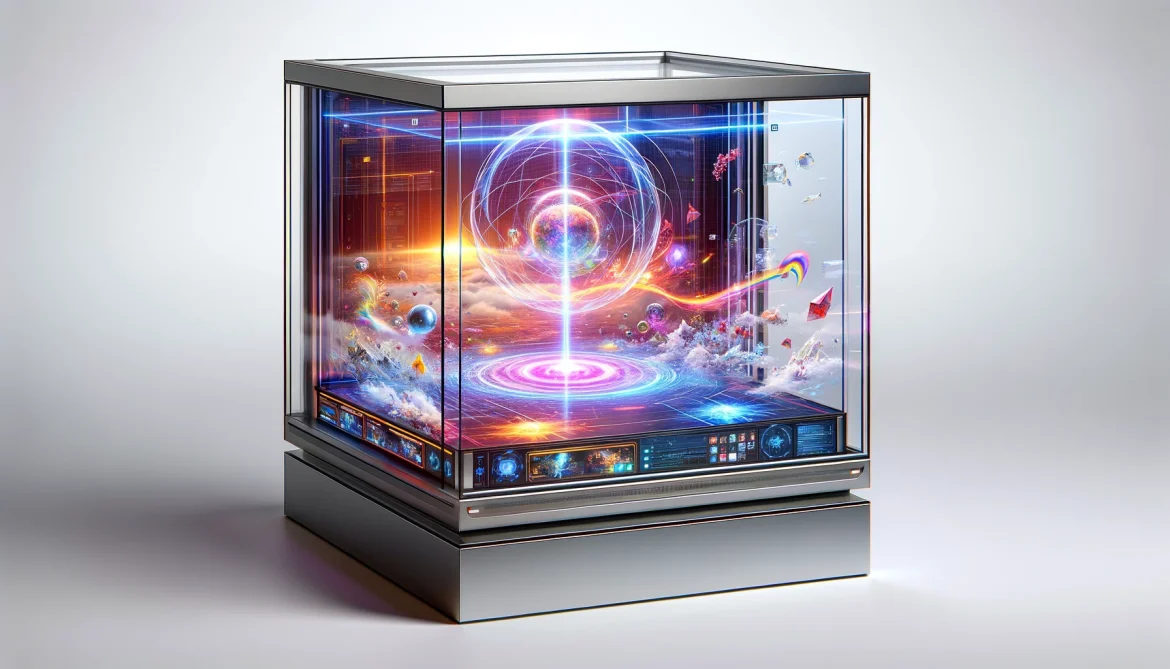Holographic displays represent a groundbreaking advancement in visual technology, transforming how we perceive and interact with digital content. By projecting three-dimensional (3D) images into physical space, holographic displays offer immersive experiences that traditional screens and monitors cannot match. This article delves into the principles of holographic displays, their applications, benefits, challenges, and future prospects.

Understanding Holographic Displays
Holographic displays use the principles of holography to create images that appear three-dimensional to the human eye. Unlike conventional displays, which present images on a flat surface, holographic displays project images into space, giving the illusion of depth and volume. The technology behind holographic displays involves capturing light patterns and reconstructing them to form 3D images.
- Principles of Holography:
- Light Interference: Holography relies on the interference of light waves to create images. When two coherent light beams—usually from a laser—intersect, they create an interference pattern. This pattern is recorded on a medium, such as a photographic plate or digital sensor, and can later be used to reconstruct the 3D image.
- Reconstruction: To view the holographic image, the recorded interference pattern is illuminated with a reference beam. This beam reconstructs the original light waves, creating a 3D image that appears to float in space.
- Types of Holographic Displays:
- Transmission Holograms: These displays use a holographic plate or film that is illuminated from the rear. The viewer looks through the plate to see the 3D image projected into space.
- Reflection Holograms: In reflection holograms, the image is projected onto a surface, and the viewer sees the 3D image by looking at the reflection of the hologram.
- Digital Holography: Digital holography uses computer-generated holograms and displays them on digital screens, such as LCD or OLED panels. This method allows for real-time manipulation of 3D images and is often used in research and development.
Applications of Holographic Displays
- Entertainment and Media:
- Virtual Concerts and Performances: Holographic displays are used to create lifelike 3D representations of performers, allowing fans to experience virtual concerts and shows. This technology has been used to bring deceased artists back to the stage, offering a unique and immersive entertainment experience.
- Interactive Gaming: In gaming, holographic displays offer players a more immersive experience by projecting 3D game elements into their environment. This enhances gameplay and provides a more engaging and interactive experience.
- Education and Training:
- Visual Learning: Holographic displays can be used to create detailed 3D models for educational purposes, allowing students to explore complex subjects, such as anatomy or engineering, in a more interactive and engaging manner.
- Simulation and Training: In training environments, holographic displays provide realistic simulations of various scenarios, such as medical procedures or industrial operations. This technology enhances training effectiveness and allows for hands-on practice in a controlled setting.
- Healthcare:
- Medical Imaging: Holographic displays offer new ways to visualize medical imaging data, such as MRI or CT scans. By projecting 3D images of internal structures, healthcare professionals can gain better insights into patient conditions and plan treatments more effectively.
- Surgical Planning: Surgeons can use holographic displays to visualize and interact with 3D models of patient anatomy before performing procedures. This aids in preoperative planning and enhances precision during surgery.
- Advertising and Marketing:
- Product Demonstrations: Holographic displays can be used in advertising to showcase products in 3D, providing customers with a more immersive and engaging way to view and interact with products.
- Retail Experience: In retail environments, holographic displays can create dynamic and attention-grabbing visual displays, enhancing the shopping experience and attracting customers.

Benefits of Holographic Displays
- Enhanced Visualization:
- 3D Depth Perception: Holographic displays offer true 3D depth perception, allowing viewers to see objects from different angles and perspectives. This enhances the realism of the displayed content and provides a more immersive experience.
- Improved Understanding: By presenting information in 3D, holographic displays improve understanding and retention of complex data, making it easier to grasp intricate details and concepts.
- Interactivity:
- Real-Time Manipulation: Many holographic displays allow for real-time manipulation of 3D images, enabling users to interact with the content and explore different aspects of the displayed information. This interactivity enhances engagement and user experience.
- Touchless Interaction: Some holographic displays support touchless interaction, allowing users to control and manipulate the display without physical contact. This is particularly useful in environments where hygiene and cleanliness are a concern.
- Innovative Experiences:
- Creative Applications: Holographic displays enable innovative and creative applications across various industries, from entertainment to education. They offer new ways to present and interact with content, driving creativity and exploration.
Challenges and Considerations
- Cost and Accessibility:
- High Costs: Holographic display technology is still relatively expensive, which can limit its accessibility and adoption. The cost of developing and deploying holographic displays remains a significant barrier for many organizations and consumers.
- Infrastructure Requirements: Implementing holographic displays often requires specialized infrastructure and equipment, which can add to the overall cost and complexity.
- Technical Limitations:
- Resolution and Clarity: Achieving high resolution and clarity in holographic displays can be challenging. Ensuring that images are sharp and detailed while maintaining the illusion of depth requires advanced technology and precision.
- Viewing Angles: The effectiveness of holographic displays can be affected by viewing angles and environmental conditions. Ensuring that the display remains effective from different angles and under varying lighting conditions is crucial.
- Content Creation:
- Complexity of Creation: Creating holographic content requires specialized knowledge and skills. Developing high-quality 3D models and animations can be complex and time-consuming, which may limit the availability of content for holographic displays.
Future Trends in Holographic Displays
- Advancements in Technology:
- Improved Resolution: Future developments in holographic display technology will likely focus on improving resolution and image quality. Advances in materials and optics will enhance the clarity and realism of 3D images.
- Affordable Solutions: As technology advances, the cost of holographic displays is expected to decrease, making them more accessible to a wider range of users and applications.
- Integration with Augmented and Virtual Reality:
- Enhanced Immersion: Holographic displays will increasingly be integrated with augmented reality (AR) and virtual reality (VR) systems, creating more immersive and interactive experiences. This integration will enhance the realism and engagement of digital content.
- Wider Applications:
- Consumer Products: Holographic displays may become more common in consumer products, such as smartphones and home entertainment systems. This will bring advanced visual experiences to everyday life.
- Industrial and Professional Use: The use of holographic displays in industrial and professional settings will expand, with applications in design, engineering, and other fields benefiting from enhanced visualization and interactivity.

Conclusion
Holographic displays represent a significant leap forward in visual technology, offering immersive and interactive experiences that traditional screens cannot match. With applications spanning entertainment, education, healthcare, and marketing, holographic displays have the potential to transform various industries and enhance the way we interact with digital content. While challenges related to cost, technical limitations, and content creation remain, ongoing advancements and future trends promise to drive innovation and expand the possibilities of holographic displays. As technology continues to evolve, holographic displays will play an increasingly important role in shaping the future of visual communication and experience.


